11. Waste
| indicator |
policy issue |
DPSIR |
assessment |
| waste and
economic activity |
is de-linking occurring? |
pressure |
 |
| municipal waste generation and
disposal |
is the 5EAP target being met? |
pressure |
 |
| biodegradable waste
landfilled |
is the Landfill
Directive target being met? |
pressure |
 |
| extra costs of incineration
compared with landfill tax |
are taxes being used to correct
the relatively low price for landfilling? |
response |
 |
| packaging waste management |
is the treatment of packaging
waste developing according to targets? |
response |
 |
Waste quantities are increasing, but
de-linking of waste from economic activity has been achieved for
some waste streams and countries. The amount of municipal waste
generated is considerably higher than the target for 2000 in the
EU’s fifth environmental action programme target, and a large
proportion of biodegradable waste is still disposed of in
landfills. However, recycling initiatives are increasing. The use
of waste taxes is increasing in Member States, but they are not yet
fully integrated into waste-management strategies. Some EEA member
countries have achieved higher recovery and recycling rates for
packaging wastes than target values.
Waste represents the loss of both material and
energy resources. Because excessive waste generation is a symptom
of inefficient production processes, low durability of goods and
unsustainable consumption patterns, waste quantities can be
considered an indicator of how efficiently society uses raw
materials.
The key environmental impacts of waste can be
summarised as:
- use of land for landfills and leaching
of harmful substances (nutrients, toxics, etc.) from
landfills;
- air pollution and toxic residues from
incinerators;
- water pollution and generation of
secondary waste streams from recycling plants;
- increased road transport.
All data on waste is associated with major
uncertainties, but it is estimated that a total of 1 300 million
tonnes of waste is generated each year in the EU. The overall aim
and priority of European waste-management policy is waste
prevention – the most challenging task for waste management. For
waste that is generated, the EU waste strategy calls for increased
recycling and energy recovery to prevent disposal, such as landfill
or incineration without energy recovery. In addition, specific
Directives impose common rules for the separate collection and
treatment of certain waste streams, such as packaging, batteries
and accumulators, waste oils, sewage sludge and polychlorinated
biphenyls (PCBs).
This chapter focuses on municipal waste and
packaging waste, both priority waste streams in the EU waste
strategy and for which policy targets have been set against which
progress can be measured. Hazardous waste, industrial waste,
construction and demolition waste, sewage sludge and waste
transport will be covered in future editions of this report.
The transport of waste, for example, is an
issue of growing concern; French studies suggest that 15 % of all
freight transport involves waste and that waste transport accounts
for 5 % of the transport sector’s total energy consumption (Ripert,
1997). Transport distances for waste recycling are also much higher
than those for disposal. The environmental pressures caused by the
transport of waste are likely to increase in the future as waste is
separated into more fractions for different treatment.
11.1. Is de-linking of waste generation from
economic activity occurring?
Removal of the link between waste generation
and economic activity has a key role in helping to meet the
objective of reduced waste generation. Waste generation appears to
be increasing at a greater rate than economic growth: the amount of
waste generated in European countries belonging to the Organisation
for Economic Cooperation and Development (OECD) increased by an
estimated 10 % between 1990 and 1995, while GDP increased by 6.5 %
(EEA, 1999).
At Member State level, de-linking of municipal
waste generation from household expenditure is occurring in some
countries (Figure 11.1). In particular, Germany, the Netherlands
and Iceland appear to show successful de-coupling of municipal
waste generation from economic activity, while other countries such
as Portugal, Greece, France, Spain, Denmark and Sweden appear not
to be making as much progress. Household expenditure, however, is
not an ideal parameter for comparison purposes as municipal waste
also includes commercial waste.
Figure 11.1:
Municipal waste generation compared with household expenditure in
selected EEA member countries, 1984-1998
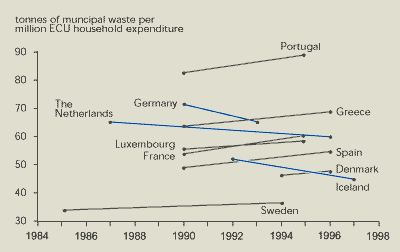
Source:
Eurostat and EEA-ETC/Waste
11.2. Are we meeting policy targets for municipal
waste generation and disposal?
Although some de-linking from economic activity
occurred in the 1990s for municipal waste, all EEA member countries
(except for Austria and Iceland) are some way away from meeting the
EU fifth environmental action programme (5EAP) target of
stabilising municipal waste generation per capita at 300 kg per
capita by 2000 (Figure 11.2).
Waste from daily household and commercial
activities (Figure 11.2 and Table 11.1) consists of certain
well-defined fractions of municipal waste, which can be compared
between all EEA member countries. These fractions include bagged
wastes (i.e. mixed waste collected from households and other
sources) and separately collected wastes such as paper, cardboard,
glass, metal packaging and food/organic waste. Bulky waste is not
included in this indicator. As waste from daily household and
commercial activities does not constitute all municipal waste, the
distance to the municipal waste target is even larger.
Figure 11.2:
Waste generation from daily household and commercial activities in
EEA member countries, 1996
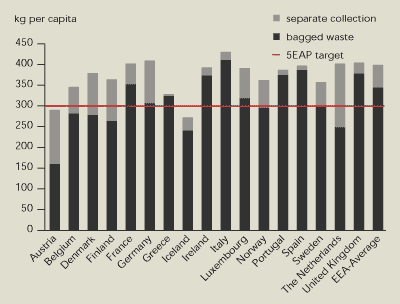
Source:
EEA-ETC/W
Notes:
Deviating reference years: France 1995; Germany 1993; Ireland 1995;
and Sweden 1994. No data for Liechtenstein.
 Waste generation per capita from household and commercial
activities is much greater than the fifth environmental action
programme target for 2000. There is a large potential for increased
recycling.
Waste generation per capita from household and commercial
activities is much greater than the fifth environmental action
programme target for 2000. There is a large potential for increased
recycling.
On the positive side, all EEA member countries
have recycling schemes and, on average, 13 % of municipal waste is
collected separately. However, wide variations exist between
countries and regions. In northern European countries, an average
20 % of waste is collected separately but large differences exist
between countries – the Netherlands leads with 38 %. In southern
European countries, an average 5 % of municipal waste is collected
separately. Overall, there is a large potential for increasing the
total amount of waste recycled.
This potential is further illustrated and
reinforced by Figure 11.3 which shows that, in 1995, too much
biodegradable waste was still going to landfill in many countries
despite the fact that such waste could be recovered as compost or
incinerated. Landfilling of biodegradable waste results in
greenhouse gas emissions and is a loss of resources. An estimated
55 million tonnes of paper, paperboard, food and organic garden
waste was landfilled in 1995 in EU Member States (less Portugal but
including Iceland and Norway). If plastics are classed as
biodegradable, this figure rises to 66 million tonnes. The Landfill
Directive sets a target of reducing the amount of biodegradable
municipal waste landfilled to 35 % by 2016, i.e. a maximum of 19
million tonnes. Minimising waste to landfill is a central plank of
the EU waste strategy and it will be important to see in future
editions of this report whether progress is made towards meeting
the Landfill Directive target for biodegradable waste.
The variation between countries in the amount
of landfill waste may be linked to the way their tax systems favour
disposal by incineration rather than landfill. A landfill tax is
operational in a number of Member States (Figure 11.4). The aim is
to improve the competitive position of recycling and incineration
with energy recovery as treatment methods. The limited capacity of
landfills is another factor which may motivate countries to impose
a landfill tax.
Figure 11.3:
Biodegradable municipal waste landfilled in EEA member countries,
1995
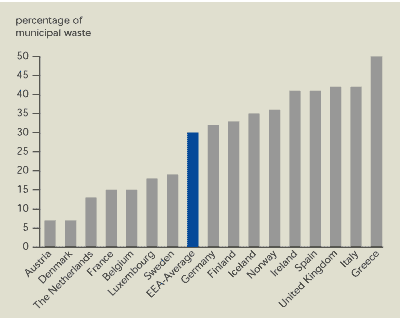
Notes:
Deviating reference years: Belgium partly 1996; Germany 1993;
Greece 1990; Italy 1996; the Netherlands 1994; and Sweden 1994. No
data available for Liechtenstein and Portugal.
 Too much biodegradable waste ends up in landfills.
Too much biodegradable waste ends up in landfills.
Figure 11.4 compares the relative costs of the
treatment and disposal of waste by landfilling and incineration for
a number of EEA member countries. In countries that have
implemented landfill taxes, less biodegradable waste than the EU
average goes to landfill. Finland is an exception; this can be
partly explained in that the price difference between incineration
and landfilling still encourages disposal to landfill over
incineration. The Finnish example shows that landfill taxes can be
effective only as part of an integrated approach to waste
management when economic instruments are used synergistically to
promote the desired environmental outcome and do not act in
opposition to each other.
Figure 11.4:
Landfill taxes in selected EEA member countries
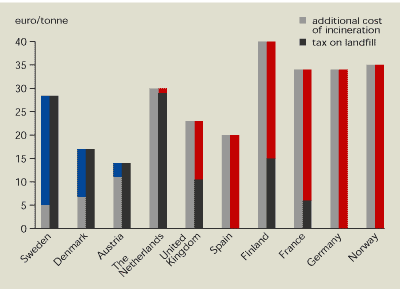
Source:
EEA-ETC/W
Note: All
prices are average observed prices and cover large variations
between plants. Denmark and Norway also have a tax on incineration;
the landfill tax shown for these two countries is the difference
between the tax on landfill and the tax on incineration with energy
recovery. The additional costs are before tax. Also Belgium has a
landfill tax, but it could not be shown due to lack of
data.
 Taxation of landfill disposal favours incineration only in
Austria, Denmark and Sweden.
Taxation of landfill disposal favours incineration only in
Austria, Denmark and Sweden.
| Closing the loop |
|
To help meet the requirements of the Landfill
Directive, Sweden has implemented an ambitious scheme to compost 10
% of all Swedish municipal waste at a single site in the near
future.
Swedish engineers have developed a way of
converting cement kilns to giant composting facilities; cement
kilns are capable of processing hundreds of tonnes of waste per day
and have a large infrastructure of storage tanks, silos, docks,
weighing stations and conveyor-belt production. Cement kilns in
Sweden are not currently operating at full capacity and older
plants are under pressure to close. Switching from manufacturing
cement to producing compost is one solution to this problem.
Organic waste material for the kilns is
provided by a collaboration of municipalities, supermarkets,
airlines and fast-food chains. The waste will be converted at a
pilot plant near Stockholm into compost pellets suitable for
application to agricultural and forestry land. The fast-food chains
‘close the loop’ by asking their growers and suppliers to use the
compost pellets in crop production.
Source:
Restructuring inefficient and polluting industries, G.Pauli.
www.zeri.org/1999/may/may_ind.htm
|
11.3. Are the EU’s objectives for packaging waste
being met?
One of the waste streams given special
attention by the EU is packaging. The Packaging Directive includes
measures aimed at preventing waste generation and increasing the
recovery and recycling of packaging waste. In 1997, 136 kg/capita
of packaging waste was generated, i.e. almost a third of total
waste from daily household and commercial activities.
Paper/cardboard is by far the largest fraction of packaging waste,
with 63 kg/capita, followed by glass (35 kg/capita) and plastics
(29 kg/capita). Metals (9 kg/capita) make up the rest.
A number of targets have been set by the
Packaging Directive. Target 1 requires Member States to reach a
recovery level of between 50 % as a minimum and 65 % as a
maximum by weight of all packaging wastes. In this case,
recovery covers all kinds of recycling, energy recovery and
composting. To achieve Target 2, Member States must reach a
recycling level of between 25 % as a minimum and 45 % as a
maximum by weight of all packaging waste. The obligation
for Target 3 is to reach a minimum recycling level of 15 %
on specific packaging waste materials.
Good rates of paper and glass recycling have
been reached, but progress with plastics has been poor (Figure
11.5). Municipal waste is the largest source of plastics waste,
generating over 61 % of total plastics waste in 1996. Only Austria
and Germany currently achieve a recycling rate of more than 15 %
for plastics waste.
Paper and plastics recovery is high in
countries where energy recovery is the predominant treatment
method. The high rates achieved by some member countries indicate
the potential for increased recycling and recovery throughout the
EEA area. For example, variations between member countries include
6 % plastics recycling in Denmark compared with 45 % in Germany.
The variation in recycling of glass is smaller.
Figure 11.5:
Recycling/recovery of packaging waste
Plastics, 1997
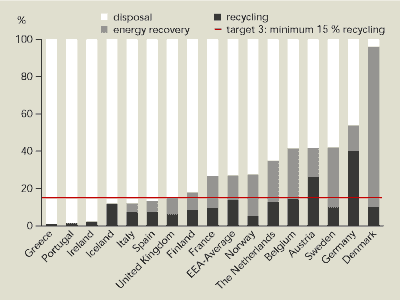
Source:
Association of Plastics Manufacturers in Europe
Glass, 1996
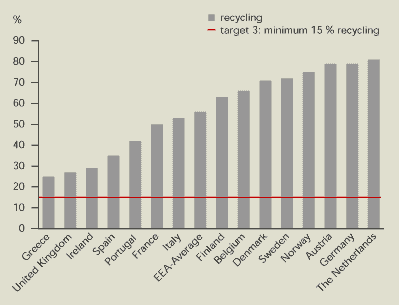
Source: FEVE
(European Container Glass Federation)
 Some EEA member countries have met the minimum requirements of the
Packaging Directive. Not all countries meet all the Directive’s
targets.
Some EEA member countries have met the minimum requirements of the
Packaging Directive. Not all countries meet all the Directive’s
targets.
Paper and cardboard, 1997

Source: Member
States’ reports to DG Environment under provisions of the Packaging
Directive.
Note: Iceland
and Ireland: 1995 data.
Four packaging materials, 1997
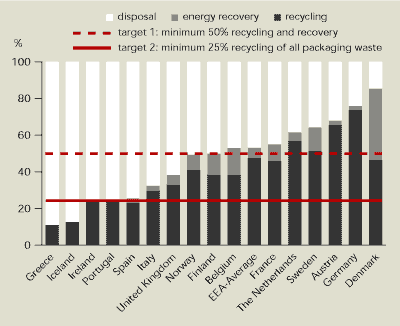
Source: Member
States’ reports to DG Environment under the provisions of the
Packaging Directive.
Note: (Energy)
Recovery includes composting and energy recovery (also biogas for
Sweden). Disposal is assumed to account for all remaining waste
which is not recovered or recycled. Waste imported for recycling
has been excluded and waste exported for recycling has been
included. The aggregated data has been weighted for amount of waste
generated for each of glass, plastics, metals and paper.
| Waste prevention |
| An integrated Norwegian approach to reducing
waste generation uses economic incentives, including a fixed levy
on one-way packaging (EUR 0.1/unit) and an environmental tax (EUR
0.4) on all packaging. The environmental tax is reduced if
packaging (e.g. bottles) is returned for recovery or re-use. If
returns within an approved system exceed 95 %, no environment tax
is paid and consequently both producers (importers) and consumers
have an economic incentive to achieve a high percentage of re-use
and recovery. An example of an approved system is the recycling of
bottles with a deposit system covering the whole of Norway. Bottles
made from glass and the plastic, PET, are re-used in a closed loop
as part of this system. Consumers pay a reasonable deposit for the
bottle, and the deposit is refunded when the empty bottle is
returned to the retailer. This recycling system leads to estimated
annual savings of 83 000 tonnes of glass waste (20 kg per capita
per year). |
11.4. Indicator development
For existing indicators, improved estimates of
generation, treatment and disposal are needed for all waste streams
as well as greater methodological consistency between countries.
Consistent and complete trends data are also lacking in many areas,
but in particular there are gaps for the base years against which
progress towards policy targets is measured. Improved information
on the use of economic instruments such as taxes would also be
useful.
For the future, priority needs to be given to
construction and manufacturing waste streams, hazardous waste and
waste transport. Analysis of the effectiveness of economic
instruments and the synergies between them, in particular taxes and
voluntary agreements for meeting policy objectives, would be
desirable.
| Table 11.1: Waste
generation from daily household and commercial activities,
1996 |
|
Unit: kg/capita |
| |
bagged
|
organic/food
|
paper/cardboard54
|
glass
|
metal
|
total
|
| Austria |
160 |
45 |
54 |
26 |
5 |
290 |
| Belgium |
281 |
6 |
32 |
22 |
5 |
346 |
| Denmark |
278 |
13 |
63 |
25 |
0 |
379 |
| Finland |
262 |
14 |
77 |
6 |
4 |
364 |
| France |
352 |
0 |
24 |
23 |
3 |
402 |
| Germany |
306 |
12 |
58 |
30 |
3 |
409 |
| Greece |
324 |
0 |
0 |
4 |
0 |
328 |
| Iceland |
240 |
0 |
21 |
11 |
0 |
272 |
| Ireland |
373 |
0 |
9 |
11 |
0 |
393 |
| Italy |
410 |
0 |
10 |
10 |
0 |
430 |
| Luxembourg |
318 |
0 |
39 |
34 |
0 |
391 |
| Norway |
295 |
11 |
45 |
9 |
2 |
362 |
| Portugal |
374 |
0 |
1 |
12 |
0 |
387 |
| Spain |
386 |
0 |
0 |
11 |
0 |
397 |
| Sweden |
300 |
0 |
46 |
11 |
0 |
357 |
| Netherlands |
248 |
75 |
54 |
22 |
3 |
402 |
| UK |
378 |
5 |
12 |
9 |
0 |
404 |
| EEA |
344 |
8 |
27 |
18 |
2 |
399 |
| Source:
EEA-ETC/W |
Note: Data from Member States, plus Norway and Iceland. Data for France 1995, Germany 1993, Ireland 1995, and Sweden 1994.
11.5. References and further reading
European Commission/DG Environment (1998).
Database on environmental taxes in the European Union Member
States, plus Norway and Switzerland.
http://europa.eu.int/comm/dg11/enveco/database.htm.
EEA (1999). Environment in the European
Union at the turn of the century, European Environment Agency,
Copenhagen.
EEA-ETC/W (1999a). Generation of household
waste and municipal waste in member countries of the European
Environment Agency. Comparability and non-comparability. Draft
report to the European Environment Agency, Copenhagen.
EEA-ETC/W (1999b). Construction and
demolition waste management practices and their economic
impacts. Report to the European Commission/DG Environment.
European Environment Agency, Copenhagen.
Eurostat (1999). Waste Generated in
Europe. (Draft). Luxembourg.
Ripert, C.(1997). La logistique et le
transport des déchets ménagers, agricoles et industriels.
ADEME, Agence de l’Environnement et de la Maîtrise de l’Energie.
Ministère de l’Equipement des Transports et du Logement.








Document Actions
Share with others